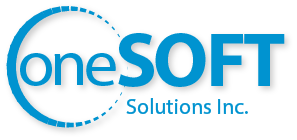Two weeks ago, OneSoft Solutions CEO Dwayne Kushniruk hosted an investor presentation at the Planet MicroCap Showcase event.
Several investors fielded questions, but due to time constraints Mr. Kushniruk couldn’t answer them all. However, we present these questions and Mr. Kushniruk’s answers following the video presentation and disclaimer below.
Disclaimer
The following questions were asked by attendees of the Planet MicroCap Showcase Virtual Investor Conference held on April 22, 2020. Management is providing responses to the questions asked, for which insufficient time during the meeting was allotted to respond.
All information discussed herein has been previously disclosed in public filings, including the Management Discussion and Analysis and Financial Statements for the year ended December 31, 2019 and/or in prior publicly disclosed documents filed on SEDAR.
We consider the responses made herein to be reasonable, but caution the reader that these responses include assumptions regarding future events, many of which are beyond our control, and may ultimately prove to be incorrect since they are subject to risks and uncertainties that affect us. We disclaim any intention or obligation to update or revise any forward-looking statements, whether as a result of new information, future events or otherwise, except as required by securities regulation. Readers are encouraged to review future disclosures on SEDAR and the www.onesoft.ca website to keep updated as to the Company’s progress.

Dwayne Kushniruk
OneSoft Solutions CEO
Now on to the Q&A.
1. Where would you like to be in 3 to 5 years in terms of sales? What is your long-term goal?
We expect to double 2019 revenue in 2020 and thereafter hope to continue this pace of revenue growth in the foreseeable future, as we believe that CIM may reach a tipping point for disruption of the legacy systems that are being used today.
2. Your share structure is really getting up there………any comments on a reverse split with a meaningful catalyst to support the new higher price? You don’t want the share price to drift down again.
We’re mindful of our capital structure and review it at every Board meeting. We have 114 million shares issued and outstanding with 9 million options outstanding. A reverse share split to consolidate shares is something that we constantly review, since a smaller share count and higher share price would likely be attractive to U.S. institutions. Note that insiders of our company own a big piece of the company, so we’re focused on building a recurring revenue, high-margin business rather than promoting stock. As we succeed with growing the business, we believe the stock price will take care of itself, and given the uncertainty and volatility in the markets, we believe this is the right approach to creating real value for investors.
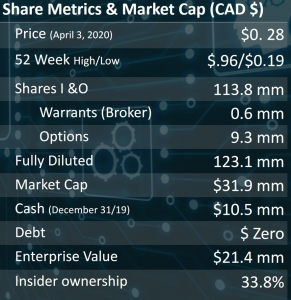
Broadly speaking, we anticipate that 2020 and 2021 will be strong from a business development perspective – i.e., addition of new clients and industry joint venture projects that are expected to bolster CIM platform use. This could support corporate development initiatives in the future, potentially including the reorganization of share structure and elevating the Company to trade on a major exchange when timing is right.
3. When do you expect to have a complete product for the non-piggable part of the market?
To recap, a PIG is a device that is inserted into pipelines to collet data as the oil or gas pushes it along. This inline inspection (ILI) data is what our machine learning solution, called Cognitive Integrity Management (or CIM), analyzes to predict pipeline failures. In the U.S., there are about 660,000 miles of piggable and 2.1 million miles of non-piggable pipelines. The latter segment needs to be managed based on various other data sets that exclude ILI data. We raised $9.2 million in April 2019 to accelerate R&D of new software products, including functionality to address the non-piggable market segment. Such development commenced in H2 of 2019 and we continue to work on these projects with expectation to start commercializing components of this new functionality by the end of 2020.
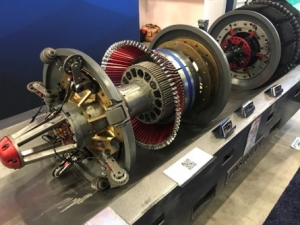
A pipeline inspection gauge (PIG) on display at PPIM 2020 this past February.
4. What seems to be the headwinds why you can’t convert pilot programs to revenue customers? P66 has been with you for quite awhile and thought others would follow.
Disruption of processes used for decades represent significant changes for large companies, which requires time and patience to work through. Lengthy sales cycles may continue for a while longer, but we expect them to shorten as our solution gains more validity and traction in the marketplace, and as potential clients gain more insight regarding digital transformation. We are not in control of timing of our clients. We have pivoted our sales approach to experiment with onboarding smaller projects, rather than focusing on company-wide adoption of our solution, which we believe may reduce sales cycles (i.e., our land and expand strategy).
Sales cycles with our current clients have varied between 1 and 3 years. Onboarding clients in 2019, particularly the larger operators, provided great insight regarding the challenges they encounter as they transition to new systems and processes, and how we can streamline processes to scale addition of new clients. One of the biggest issues is that employees involved with implementation of new systems often get pulled away to handle other high priority tasks, which slows the on-boarding process significantly. Secondly, issues regarding finding, organizing and loading of the historic data that has been collected over decades have been consistent challenges amongst our clients. To address these issues, we developed tools during H2 of 2019 to streamline and automate the onboarding process and revamped our role in the onboarding process, so that we can now essentially implement the software without dependence on the client’s participation, other than to have them point us where to find the historic data. Using this new approach, we believe that we can now reduce the onboarding process from months to weeks and streamline the client’s involvement in the process to training only, once CIM is up and running within their organization.
About 60 enterprise level pipeline operators manage the vast majority of the U.S. pipeline infrastructure – this is the group that we have targeted to date, and more specifically, the companies within this group that have proclaimed a digital transformation strategy to move to the cloud. When we started sales efforts in 2017, before digital transformation was embraced by the industry, we found that 6 to 12 months was typically added to the sales cycle, just to explain the advantages of digital transformation and cloud computing. Today, we have sharpened our sales focus to work only with companies that already understand these benefits. Those that don’t are referred to Microsoft, who dispatch their sales teams to convince the IT and C-suite teams from potential customers regarding the benefits of digital transformation, prior to our employees expending sales efforts regarding CIM. For the enterprise level companies that have engaged a digital transformation strategy, our sales team works collaboratively with Microsoft sales personnel, focusing on IT and C-suite executives who are driving digital transformation initiatives within their companies. We anticipate that this pivot in our sales strategy will shorten sales cycles by focusing on the enterprise players who understand and want digital transformation, and who will serve to validate our solutions for the rest of the market players.
The new onboarding tools that we developed are highly important for the other 20% of the U.S. industry, which consists of about 1,800 tier 2 and tier 3 companies. We anticipate that the new onboarding tools will eventually accommodate a self-service SaaS business model, to support self- and consultant-onboarding of CIM, essentially streamlining the sales and implementation processes and creating a platform to expand our technology into other markets (e.g., municipal water and sewer).
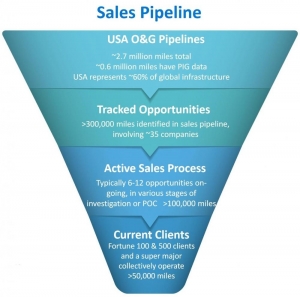
5. Is it accurate that pipeline operators have long term contracts so the recent decline in oil prices won’t impact them? How much money will your customers save using your solution vs their current practices?
Yes, this is our understanding. We have not seen any negative impact to our business thus far from reduced oil prices. In fact, we believe that constrained budgets could help our business because of the high value proposition our solution provides by increasing efficiencies and reducing costs , as further explained in our “Repair Fraction” white paper that was published and presented to the industry in February, 2020.
6. Of the 51k miles contracted…what % has been onboarded?
While all 51,000 miles under contract now generates base subscription revenue, operators vary in how quickly they load data for all their pipeline segments. Our experience so far indicates that operators have taken between 6 and 18 months to load all of their data onto CIM and implement their entire pipeline infrastructure. Refer to page 11 of our Fiscal 2019 MD&A for further information about how revenue builds by client.
7. What is your cash burn? Great presentation thank you.
As of December 31, 2019, we had about $10.5 million of cash and no debt. Cash burn in 2019 was about $2.5 mm (average $634k per quarter). Based on our sales activity we expect this metric to improve in 2020, and do not have any concern about having sufficient cash to execute our business plans as envisioned during the foreseeable future.
8. I haven’t seen you sign up any new customers in a long time. Why, and when do you expect to announce some new ones?
We expect to announce new clients in 2020, but timing is unknown as this is not in our control.
We had a lot of momentum going into PPIM in February 2020, the U.S. pipeline industry’s premier annual event. At that conference services providers, PIG vendors and prospective customers spent time at our booth talking about proof of concept projects and joint-venture initiatives, based on our CIM platform. The end of February was the last time we were able to have in-person meetings. Covid-19 then abruptly ceased progress for the next month or so, as businesses were scrambling to determine how to mitigate the impact to their operations. Activities have since returned to a new “near normal” regarding sales and business development progression through use of on-line rather than face-to-face meetings. So although we’ve encountered some delays, it appears that we are back doing what needs to be done to progress sales activities.
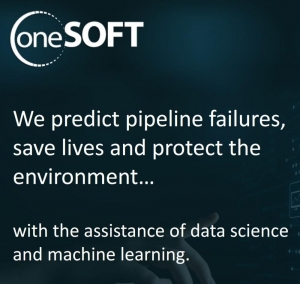
9. How has the transition from working at home been going for your current clients?
First, let me discuss OneSoft’s situation with respect to the impact of Covid to our business operations. Even before Covid, and dating back to 2015, all of our employees worked remotely from home offices, except for our CFO and Controller who work from a shared office facility. Many of our corporate meetings and communications before Covid were held through on-line video conferencing, so we haven’t experienced the disruption most other businesses have.
An interesting side observation is that we are one of the few companies that continues to be hiring new employees (we currently are recruiting for 4 open positions), within a personnel environment that has changed dramatically in the past couple of months. The talent pool from which to select new employees has increased in the past couple of months because, we suspect, Covid has caused termination of projects that has freed up talent we are seeking. The pandemic has had minimal disruption to our ability to service our clients and following the month or so of delays we encountered in March we have recently seen a return to more normal sales and business development activities. We believe this is because the people we need to communicate with required some time to organize on-line meeting capability to replace conventional face to face meetings but have now incorporated this change.
The Covid disruption amongst our clients and prospective customers is mixed. Our clients, who already adopted our cloud computing solutions have essentially been able to transition seamlessly from conventional office to home working environments. This contrasts with most of the prospective customers we are engaged with, who have generally encountered more difficulty in transitioning their employees to work from home-based offices. Interestingly, Covid may potentially be a catalyst that helps motivate future sales, because many of our prospective customers now have an abrupt new appreciation for how cloud computing can enable their employees to work effectively from home offices, as a result of having capability to access critical data using any web-connected device.
10. Have you seen greater demand for your platform with the recent decline in crude prices? Would imagine a catalyst right now is process efficiency now more than ever.
Volatility of oil and gas price does not appear to have a direct effect on our business in the same way it affects the upstream and downstream segments of the industry. Transportation of oil and gas (the midstream segment) is still required, irrespective of energy prices, and our clients typically have long term contracts that preserve their revenue streams for transporting products that are not energy-price dependent.
Following the 2008 global economic recession, our understanding is that pipeline operators normally entered into long-term transportation contracts with their own customers – the oil and gas producers – in order to secure stable revenues and cash flows. We also understand that in some cases pipeline operators need to keep product flowing in order to preserve lease rights, which is more crucial than temporarily reducing throughput during periods of low energy prices.
And a highly compelling factor that supports our opportunity within the U.S. is that PHMSA, the U.S. pipeline regulator, mandates that pipeline data must be collected on piggable pipelines every 5 or 7 years at minimum, for liquids and gas lines, respectively. In addition, PHMSA’s new “mega-rule” is scheduled to take effect July 1, 2020, which further bolsters our opportunity, as more pipeline will be required to be operate in accordance with federal regulations that call for enhanced data collection and analyses capability, which CIM addresses. Overall, we believe that our Company is fairly well insulated from the volatility pricing of oil and gas and well-positioned to be the vendor of choice as regulatory operating requirements are enhanced.

11. You have a number of pricing structures in your annual information filings. (a) What seems to be the most popular choice? (b) What is the agreement with Phillips 66 after 10 years? (c) How are you thinking about all the non piggable pipelines in context of your software development? (d) Do you have interest globally at this stage?
(a) We have developed various pricing structures in response to what clients and prospective customers have asked for. We anticipate that some clients may start with one pricing structure for a small segment of their pipelines and later adopt a different pricing structure, as they onboard more pipeline data. We are focused on increasing initial adoptions of CIM, thus attempt to remove all the barriers to this objective. The various pricing structures assist in doing this, and we have high confidence that clients who commence using CIM for a portion of their pipeline will see value in onboarding all of their pipelines. In short, the different pricing structures support our “sign new logos” and “land and expand” strategies.
(b) Clients like Phillips 66 will need to retain some sort of integrity management processes beyond the duration of contracts we have entered into. We have high confidence that with our first mover advantage and committed strategy to continued focus on new product development we will be able to maintain and extend our competitive moat, and thereby extend client relationships. It is neither practical or probable that clients will abandon our advanced machine learning/data science technology and return to using legacy processes and systems that do not deliver CIM-type capability. In short, we believe that our clients will remain with us, providing we continue to advance our solutions.
(c) We have aggregated more data than anyone else we are aware of at this point, which provides opportunity to leverage learnings from this data that can be applied to all pipelines, including those for which inline inspection data has not been gathered. We are already working on new solutions for the 2.1 million miles of pipeline that falls under “Direct Assessment” U.S. regulatory mandates, which we anticipate will start to roll out as commercial solutions in 2020.
(d) We are already involved in sales activities outside of the U.S. Two of our current clients have plans to implement CIM in their subsidiaries within other countries, and we are actively pursuing potential sales in various countries including Argentina, Brazil, Australia and Middle East regions, both directly, and collaboratively with Microsoft international sales teams and other O&G industry vendors.
12. Where do you see our business in the next 10 years? Will oil & gas still be viable at that point? Or will it be replaced by other clean energy? If so, what will you do to navigate our company to avoid that judgement day?
Most pundits agree that oil and gas energy will still be required for the next 30 years at minimum, irrespective that new energy sources are being developed. During this time pipeline infrastructure globally, which is ever-aging, will need to be maintained to ensure reliability and in accordance with regional regulatory requirements that apply. In some jurisdictions such as the U.S. these are becoming more stringent. Our belief is that we expect to be busy with the O&G pipeline market for decades.
We also believe that our technology can be adapted for municipal water & sewer, and potentially railroad/rail transit industries. We have recently commenced investigation of the municipal water market, which closely resembles the O&G pipeline market (i.e., steel pipes that corrode, and inspection tools are used to collect snapshots of data).
13. Can you disclose who are the other pipeline operator customers beyond Phillips?
We are prevented from disclosing our client names because of confidentiality terms we agreed to when contracting these clients.
While we can’t make these disclosures, I would note that potential customers, particularly within the U.S. and Canada, are generally quite well aware of the companies that have adopted CIM, as this information is often shared at various industry conferences and meetings. During the past year, we haven’t had need to include history/background of our Company in sales meetings, as prospective customers we are now meeting with understand who we are and what we do, as a result of peer to peer discussions about our company and technology.
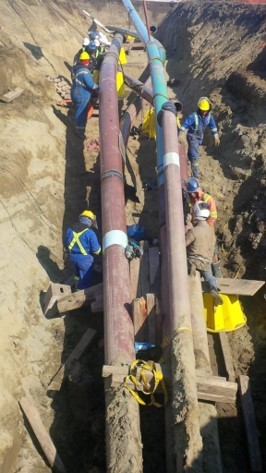
14. How many miles of pipeline in total is the company managing? (b) And at which point will the company turn a profit?
(a) We currently have 51,000 miles under multi-year contracts, and more than 100,000 miles in our sales pipeline.
(b) We did post a small profit for the period ended December 31, 2018, but decided to raise more capital to fund acceleration of R&D and new product development in April 2019 to increase our competitive moat, rather than focus on bottom line profits. We believe that we can create higher value for shareholders by advancing our first mover advantage, signing new logos and increasing recurring revenues, which is the metric that generally governs SaaS company valuations. We believe that new client additions are key to future opportunities, as it is highly probable that they will ultimately onboard our solutions for all of their pipeline segments once they experience the value proposition of using CIM. This justifies the relatively low introductory pricing models and incurrence of onboarding costs for new clients. While these strategies contribute to increased costs in the short term, they set the stage for greater recurring, profitable business in the longer term.
15. What is the Philips 66 royalty rate, what is the cap and when do you anticipate having paid it off?
This information is confidential, as required to comply with our agreement and for competitive reasons. The royalty is capped, which provides us the option of retiring the obligation whenever we choose to. We do not consider royalty expense to be material, relative to revenues that we expect to occur over time.
16. Is there seasonality in recurring revenues? Why was the Q4 quarter down on the Q2 quarter in 2019?
We anticipate quarterly revenues to continue to be somewhat lumpy over the next year as one of the major revenue components, associated with loading of inline inspection data sets onto CIM, is dependent on clients’ timing. I suggest that you review the Fiscal 2019 year-end MD&A published on SEDAR to understand the revenue components and revenue recognition factors discussed in the document. One of the important factors to monitor is the “Deferred revenue” recorded on our balance sheet, which typically represents pre-paid consumption of CIM by clients, as expected to unfold during the ensuing year. We anticipate that timing to load inline inspection data sets onto CIM will continue to vary by client, thus revenue recognition will vary accordingly.
17. Do you have enough cash to continue operations for the next 12 months? Is there any plan to raise additional capital and/or cause even further shareholder dilution?
Cash burn in 2019 was ~$2.5 million, and we expect this to improve in 2020. With $10.5 million in cash, and no debt, we believe we have sufficient cash to execute our business plans as currently envisioned, without requirement to raise additional capital.
